Vietnam is a captivating destination that sits high on the list for many adventurers exploring Southeast Asia. It’s a land where your budget stretches remarkably far, offering incredible value for intrepid travelers. Beyond the affordability, Vietnam boasts a tapestry woven with rich history, vibrant culture, and breathtaking natural landscapes, ranging from dramatic mountains in the north to serene beaches and fertile deltas in the south. It’s easy to see why Backpacking Through Vietnam promises an experience like no other, connecting you deeply with both the land and its resilient people.
What truly sets Vietnam apart, in my experience, is its phenomenal food scene. The cuisine is a journey in itself, evolving wonderfully from one region to the next, yet consistently delivering on flavor, freshness, and affordability. It’s more than just sustenance; it’s a reflection of history, geography, and local ingenuity. From bustling street stalls to hidden gems, every meal offers a chance to understand the local palate and way of life. Follow this guide as we journey from south to north, uncovering the essential stops and experiences that make Backpacking Through Vietnam such a rewarding adventure.
Starting Point: Dynamic Ho Chi Minh City
Our adventure begins in the energetic southern metropolis formerly known as Saigon. Ho Chi Minh City is often the first taste of Vietnam for backpackers arriving by air. This city is a whirlwind of activity, a fascinating blend of historical reflection and future-focused dynamism. It’s here that you first dive into the incredible world of Vietnamese cuisine, and perhaps nowhere is more famous for the ubiquitous banh mi. Often credited as the birthplace of this now-famous sandwich, HCMC offers countless variations, each a testament to local flavors housed within a crispy baguette legacy of French colonial times.
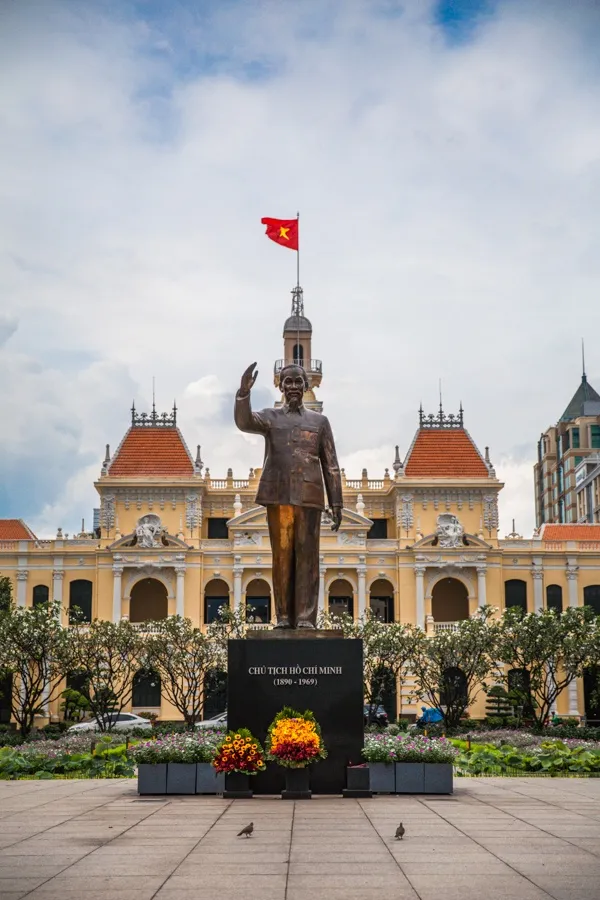 Skyline of Ho Chi Minh City, a key stop when Backpacking Through Vietnam
Skyline of Ho Chi Minh City, a key stop when Backpacking Through Vietnam
Ho Chi Minh City serves as a crucial entry point to understanding Vietnam’s recent history. Sites like the War Remnants Museum offer a powerful, albeit graphic, perspective on the Vietnam War (referred to here as the American War). Just outside the city, the Cu Chi Tunnels provide a tangible glimpse into the incredible perseverance and ingenuity of the Vietnamese people during the conflict. Exploring these sites adds a profound layer of context to your journey through the country.
Fun Things to Do in Kissimmee Florida
Where To Go In Waikiki – Your Ultimate Guide to Hawaii’s Iconic Beachfront
The Best Things to Do in Naples – Your Ultimate Italian Experience
Beyond its historical weight, HCMC buzzes with modern life. You can admire stunning French colonial architecture, find solace in serene pagodas tucked away in busy districts, or browse the unique offerings on Book Street. The city’s energy is infectious, a lively introduction to the pace of life in Vietnam. Choosing the right place to stay is key to experiencing the city – whether you prefer the social vibe of a budget hostel or the comfort of a boutique hotel, HCMC offers options for every backpacker’s style.
Exploring the Vital Mekong Delta
A short journey south of Ho Chi Minh City brings you to the vast and fertile Mekong Delta. Known as Vietnam’s “rice bowl,” this region is defined by the mighty Mekong River and its intricate network of tributaries, canals, and waterways. While a day trip is possible, dedicating a couple of days allows for a deeper appreciation of life intertwined with the river. Can Tho city serves as an excellent base for exploring the delta’s wonders.
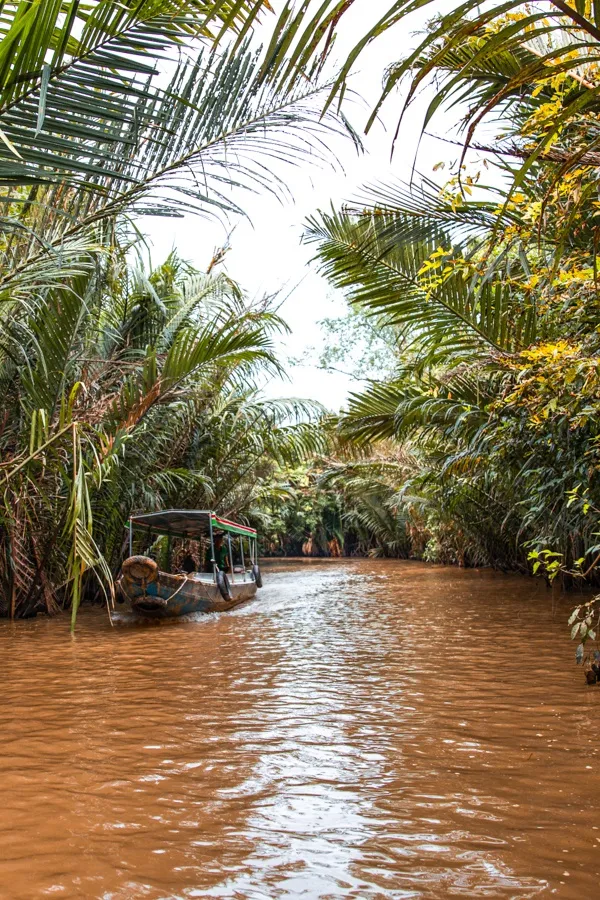 Local boat navigating the waterways of the Mekong Delta while Backpacking Through Vietnam
Local boat navigating the waterways of the Mekong Delta while Backpacking Through Vietnam
Taking a boat cruise is essential. These excursions navigate through lush landscapes, past stilted houses, and vibrant floating markets like Cai Rang, where vendors sell goods directly from their boats – a centuries-old tradition reflecting the delta’s commerce centered on its waterways. Beyond the markets, exploring small villages by boat or bicycle offers a peaceful contrast to the city. Cycling along narrow paths flanked by rice fields and fruit orchards provides a sensory experience, connecting you to the agricultural heart of Vietnam.
The Mekong Delta offers a unique cultural immersion. You can visit local workshops producing traditional goods like coconut candy or rice paper, and sample incredibly fresh tropical fruits grown in the region. The pace of life here is slower, dictated by the rhythm of the river and the cycles of nature. It’s a place to witness authentic rural life and appreciate the bounty that the Mekong provides.
Coastal Retreats: Mui Ne and Nha Trang
Moving along the coast, you encounter different beach vibes. Mui Ne, historically a fishing village, has evolved into a popular coastal destination known for its unique natural attractions and watersports. Unlike some of the country’s more party-centric beaches, Mui Ne offers a slightly more relaxed, resort-town atmosphere, though backpacker-friendly options are available.
The most striking features of Mui Ne are its remarkable sand dunes – the Red Dunes and the White Dunes. Visiting these is like stepping into a small desert landscape right next to the ocean, a surprising sight in Vietnam. You can rent sleds to slide down the slopes or simply enjoy the photogenic scenery. Mui Ne is also renowned as a hotspot for kite surfing and windsurfing due to consistent strong winds, offering an active water sports experience. While it may feel more developed than some other spots, it provides a pleasant coastal pause.
Further north lies Nha Trang, another major coastal city. Nha Trang is known for its long sandy beach and bustling urban environment. Historically, it’s been a hub for tourism, sometimes carrying a reputation for a more commercialized, party-oriented atmosphere compared to Mui Ne or the more laid-back Hoi An coast.
Nha Trang offers standard beach activities like swimming, sunbathing, and boat trips to nearby islands for snorkeling or diving. The city itself has historical sites like the Po Nagar Cham Towers, which offer a glimpse into the region’s Champa history. While it serves as a convenient stop on the north-south route, many backpackers find themselves drawn to other coastal areas for a more tranquil or culturally rich experience.
The Charming Highlands: Da Lat
Heading inland into the cool highlands, you discover Da Lat, a city with a distinctly different character. Often referred to as the “City of Eternal Spring” due to its pleasant year-round climate, Da Lat is a favorite getaway spot for Vietnamese tourists, which contributes to its unique, slightly quirky charm. Its European-influenced architecture, pine forests, and flower gardens give it a romantic and somewhat whimsical feel.
Da Lat is famous for its eccentric attractions, most notably the “Crazy House” (Hang Nga Guesthouse), an architectural marvel resembling a giant tree house or a surreal fairy tale structure. Strolling around Xuan Huong Lake in the city center is a popular pastime. The surrounding countryside is dotted with waterfalls, pagodas, and lakes. Renting a scooter to explore sights like the Truc Lam Buddhist Monastery accessible by cable car, the powerful Elephant Falls, or the serene Linh An Pagoda allows for independent discovery of the beautiful highland scenery. Even unexpected rain can add to the adventurous spirit of exploring Da Lat’s misty hills.
Da Lat’s local popularity means you get a more authentic glimpse into Vietnamese leisure culture. The food scene offers local specialties, and the markets are vibrant with fresh produce and flowers from the surrounding farms. It’s a refreshing change of pace and climate from the coastal heat, providing a different facet to your Backpacking Through Vietnam journey.
Venturing Off the Beaten Path: Yok Don National Park
For those seeking genuine solitude and a break from the typical backpacker trail, Yok Don National Park in the Central Highlands offers a compelling option. Getting here requires a bit more effort, which is precisely why it remains relatively untouched by mass tourism. It provides an opportunity to connect with nature and experience a less-developed side of Vietnam.
 An elephant walking in Yok Don National Park, a destination for nature lovers Backpacking Through Vietnam
An elephant walking in Yok Don National Park, a destination for nature lovers Backpacking Through Vietnam
Yok Don is one of Vietnam’s largest national parks, protecting significant areas of dry deciduous forest. It’s home to diverse wildlife, although sightings can be challenging. Historically known for elephant riding, the park is thankfully shifting towards more ethical, observation-based elephant experiences, focusing on conservation and responsible tourism. Exploring the park typically involves guided treks through the forest, learning about the local flora and fauna, and perhaps visiting ethnic minority villages in the buffer zones.
Staying near or within the park offers a peaceful retreat. While accommodation options may be limited and slightly pricier for solo travelers compared to standard hostels, the chance for quiet contemplation and immersion in nature is unparalleled. It’s a destination for the adventurous soul willing to step away from the usual highlights and discover Vietnam’s wilder side.
The Enchanting Charm of Hoi An
Hoi An is a city that consistently captivates travelers with its timeless beauty and relaxed atmosphere. This ancient trading port, a UNESCO World Heritage site, is renowned for its well-preserved architecture, pedestrian-friendly streets, and the thousands of colorful lanterns that illuminate the town after dusk. Walking through Hoi An’s Old Town feels like stepping back in time, a truly magical experience when Backpacking Through Vietnam.
Exploring the Old Town reveals a blend of Vietnamese, Chinese, Japanese, and European architectural styles, reflecting its history as a bustling international port from the 15th to the 19th centuries. Key landmarks include the Japanese Covered Bridge, ancient houses, and Chinese assembly halls. Beyond sightseeing, Hoi An is globally famous for its tailoring scene. Hundreds of tailor shops offer the chance to get custom-made clothes, shoes, and accessories crafted surprisingly quickly and affordably, a unique cultural and practical experience.
The charm of Hoi An extends beyond the Old Town. Renting a bicycle is a popular and delightful way to explore the surrounding countryside. A short ride takes you past rice paddies and vegetable gardens to the nearby coast and beaches like An Bang, offering a perfect balance of cultural exploration and coastal relaxation. Hoi An’s culinary scene is also outstanding, famous for local dishes like Cao Lau and White Rose dumplings.
Stepping into History in Hue
Journeying north brings you to Hue, a city steeped in imperial history, situated along the Perfume River. Hue served as the capital of Vietnam during the Nguyen Dynasty from 1802 to 1945, and its past is palpable throughout the city. The most prominent historical site is the vast Imperial City, a walled citadel enclosure housing palaces, temples, and the forbidden Purple City, once home to the emperor and his family.
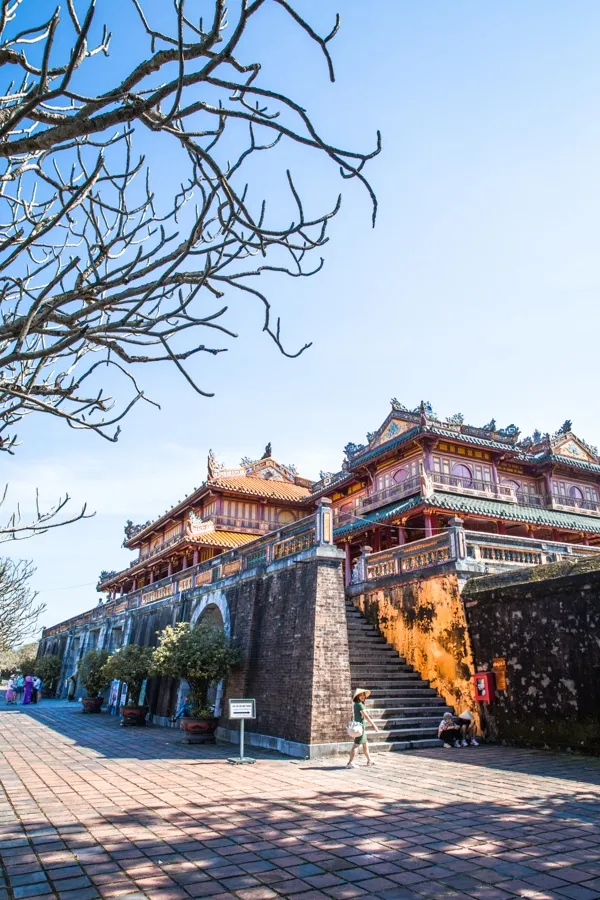 The ancient Imperial City of Hue, a historic site for those Backpacking Through Vietnam
The ancient Imperial City of Hue, a historic site for those Backpacking Through Vietnam
Exploring the Imperial City can take hours, revealing impressive architecture and gardens, though much of it was damaged during the Vietnam War. Visiting the various tombs of the Nguyen emperors scattered along the Perfume River is another essential historical experience, each tomb complex uniquely designed and reflecting the personality of the emperor it honors. Beyond the Imperial City and tombs, Hue offers a quieter pace than the southern cities.
Hue is also a significant destination for food lovers, particularly famous for bun bo Hue, a spicy noodle soup distinct from the pho found elsewhere. Its rich broth, combination of meats, and fragrant herbs reflect the sophisticated flavors associated with the former imperial capital’s cuisine. Trying authentic bun bo Hue in its city of origin is a culinary highlight of Backpacking Through Vietnam. The city’s blend of historical weight and culinary depth makes it a deeply rewarding stop.
Natural Wonders in Phong Nha-Ke Bang National Park
Leaving the historical weight of Hue behind, the landscape dramatically shifts as you arrive in Phong Nha. Located near the border with Laos, Phong Nha-Ke Bang National Park is a UNESCO World Heritage site celebrated for its stunning karst mountains, vast cave systems, and unspoiled nature. It was one of my absolute favorite non-urban areas in Vietnam, offering breathtaking scenery and incredible outdoor adventures.
The landscape is characterized by dramatic limestone karsts rising from verdant valleys and rice paddies, creating a truly picturesque setting. The park is home to some of the world’s largest caves, including Son Doong Cave (accessible only on expensive, multi-day expeditions), but also magnificent and accessible caves like Phong Nha Cave (explored by boat) and Paradise Cave (impressive stalactites and stalagmites). Dark Cave offers a more adventurous experience with ziplining and mud bathing.
Renting a motorbike is the ideal way to explore the park’s extensive road network, leading you through incredible scenery and to various caves and viewpoints. The local community in Phong Nha is incredibly friendly, adding to the welcoming atmosphere. It’s a destination perfect for nature enthusiasts and adventurers looking for hiking, caving, and exploring truly stunning landscapes away from larger crowds.
Scenic Beauty of Ninh Binh
Just a couple of hours south of Hanoi lies the province of Ninh Binh, often dubbed “Ha Long Bay on land” for its similarly dramatic karst topography rising from flat rice paddies and waterways. The natural beauty here is simply breathtaking, making it a prime location for scenic excursions and peaceful exploration. While Ninh Binh is the main city, most travelers wisely choose to stay in the nearby area of Tam Coc, which is more geared towards tourism and offers easier access to the main attractions amidst picturesque surroundings.
 Panoramic view from Hang Mua Peak in Ninh Binh, a stunning viewpoint on your Backpacking Through Vietnam adventure
Panoramic view from Hang Mua Peak in Ninh Binh, a stunning viewpoint on your Backpacking Through Vietnam adventure
One of the most popular activities is taking a traditional sampan boat ride through Trang An or Tam Coc. These tranquil journeys wind through stunning karst valleys, past rice fields, and often through natural caves and under limestone karsts, offering postcard-perfect views. Trang An is a UNESCO site known for its spiritual significance and movie-set-like scenery. Climbing the hundreds of steps to the peak of Hang Mua offers a challenging but incredibly rewarding panoramic view of the Tam Coc area and the river winding through the karsts – an iconic vista of Backpacking Through Vietnam.
Cycling through the flat countryside between attractions is another wonderful way to soak in the scenery, passing villages, farms, and water buffalo. Ninh Binh provides a serene escape and some of Vietnam’s most visually striking landscapes, making it a memorable stop before reaching the bustling capital.
The Cultural Hub: Hanoi
Hanoi, the capital of Vietnam, is a city that effortlessly blends the old and the new, the East and the West. Its history spans over a thousand years, palpable in the ancient streets of the Old Quarter, while French colonial architecture adds layers of elegance and charm. Hanoi is a sensory explosion – the constant hum of motorbikes, the calls of street vendors, the aroma of street food, and the vibrant colors of daily life.
![]() Iconic Train Street in Hanoi, a unique cultural spot during your Backpacking Through Vietnam journey
Iconic Train Street in Hanoi, a unique cultural spot during your Backpacking Through Vietnam journey
The Old Quarter, with its labyrinthine streets named after the goods traditionally sold there (Silk Street, Silver Street), is a must-explore. It’s here you find countless cozy cafes and some of Vietnam’s most famous dishes. Hanoi is considered the birthplace of pho, and tasting an authentic bowl from a street vendor is a quintessential experience. Another local specialty is egg coffee (ca phe trung), a surprisingly delicious concoction created out of necessity during a condensed milk shortage; trying it at a historic spot like Cafe Giang is a must. The city’s French influence is evident in its tree-lined boulevards, stately colonial buildings, and peaceful lakes like Hoan Kiem Lake.
Hanoi serves as the primary gateway to northern Vietnam’s iconic destinations. It’s the jumping-off point for cruises to Ha Long Bay’s stunning limestone karsts and treks in the terraced landscapes of Sapa. The city offers excellent opportunities for shopping in bustling markets and exploring museums and historical sites that delve deeper into Vietnam’s past. Its vibrant street life and rich cultural heritage make it an essential stop when Backpacking Through Vietnam.
The Legendary Ha Long Bay
From Hanoi, a popular excursion takes you east to the legendary Ha Long Bay. This UNESCO World Heritage site is famous for its surreal seascape of thousands of limestone karsts and islets rising dramatically from the emerald waters of the Gulf of Tonkin. According to local legend, the karsts were formed by dragons descending from heaven to protect Vietnam.
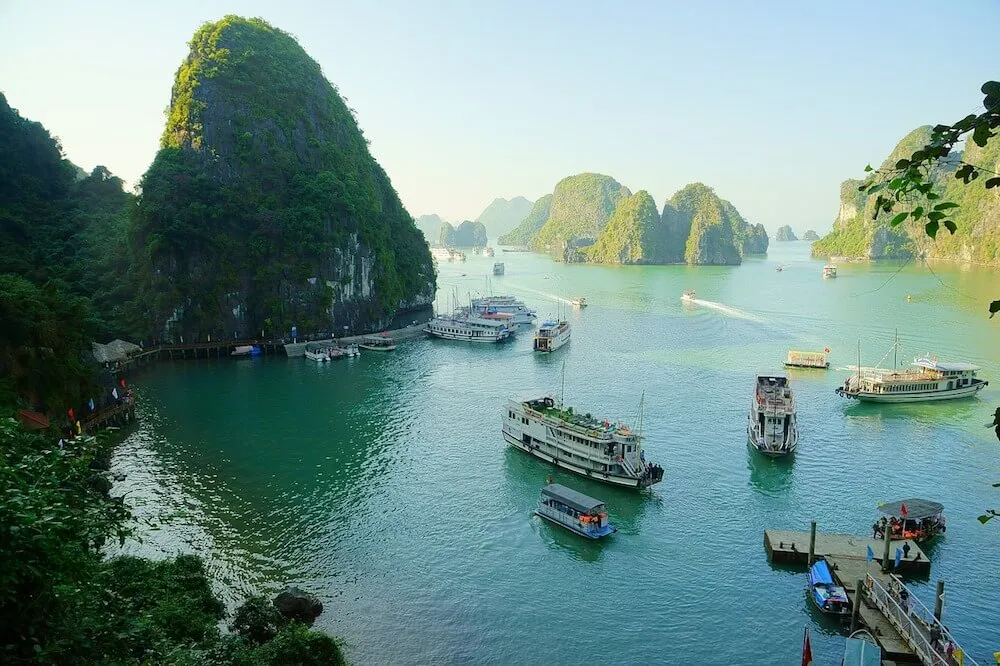 Limestone karsts rising from the water in Ha Long Bay, a popular highlight for Backpacking Through Vietnam
Limestone karsts rising from the water in Ha Long Bay, a popular highlight for Backpacking Through Vietnam
Cruising through Ha Long Bay is the primary activity, with options ranging from budget-friendly overnight trips to more luxurious multi-day tours. These often include activities like kayaking or swimming in secluded coves, visiting caves hidden within the islands, and stopping at floating fishing villages. There are also party cruises available for those seeking a more social experience. Booking through reputable tour operators in Hanoi is common, and it’s often possible to negotiate prices.
While Ha Long Bay can feel touristy due to its immense popularity, the sheer scale and unique beauty of the landscape are undeniable. Choosing the right cruise and duration can significantly impact your experience, allowing you to find moments of tranquility amidst the iconic scenery. It’s a natural wonder that forms an unforgettable highlight of Backpacking Through Vietnam.
High Altitude Adventures in Sapa
Heading north into the mountains near the Chinese border brings you to Sapa, a region renowned for its dramatic terraced rice fields and rich ethnic minority cultures. Trekking in Sapa offers a chance to immerse yourself in stunning landscapes and connect with local communities, making it a powerful cultural and physical experience on your journey.
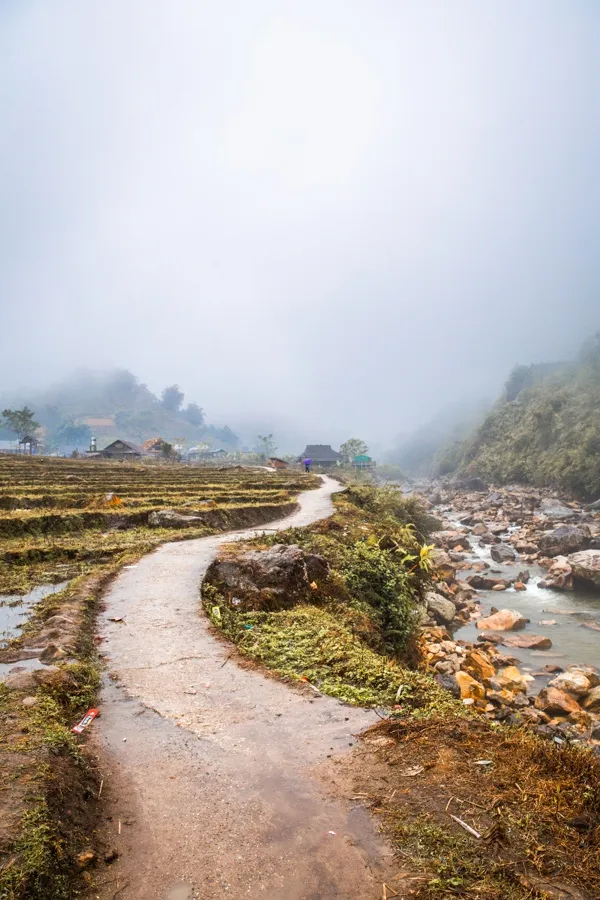 Terraced rice fields and ethnic minority trekkers hiking in Sapa, a cultural experience Backpacking Through Vietnam
Terraced rice fields and ethnic minority trekkers hiking in Sapa, a cultural experience Backpacking Through Vietnam
Sapa is home to several ethnic minority groups, including the Hmong, Red Dao, Tay, Giay, and Xa Pho, each with their distinct languages, traditional clothing, and customs. Many travelers opt for guided treks ranging from one day to several days, often including homestays in local villages. This provides invaluable insight into their way of life, farming practices (particularly the intricate terraced fields), and unique traditions.
The landscape of Sapa is characterized by steep valleys carved with stunning rice terraces, especially vibrant green during the planting season or golden during harvest (September-October). Hiking through these fields and between villages offers breathtaking views and the chance to interact with local people. While popular, Sapa retains its charm, offering a profound cultural exchange alongside challenging but rewarding treks. Be prepared for potentially unpredictable weather, especially outside the peak seasons.
The Epic Ha Giang Loop
Further north, in the most remote reaches of Vietnam, lies the Ha Giang province and its legendary Ha Giang Loop. This multi-day motorbike journey is widely considered one of the most spectacular road trips in Southeast Asia, offering unparalleled mountain scenery, winding passes, and encounters with ethnic minority communities living in traditional villages. Backpacking Through Vietnam isn’t complete for many without tackling this epic route.
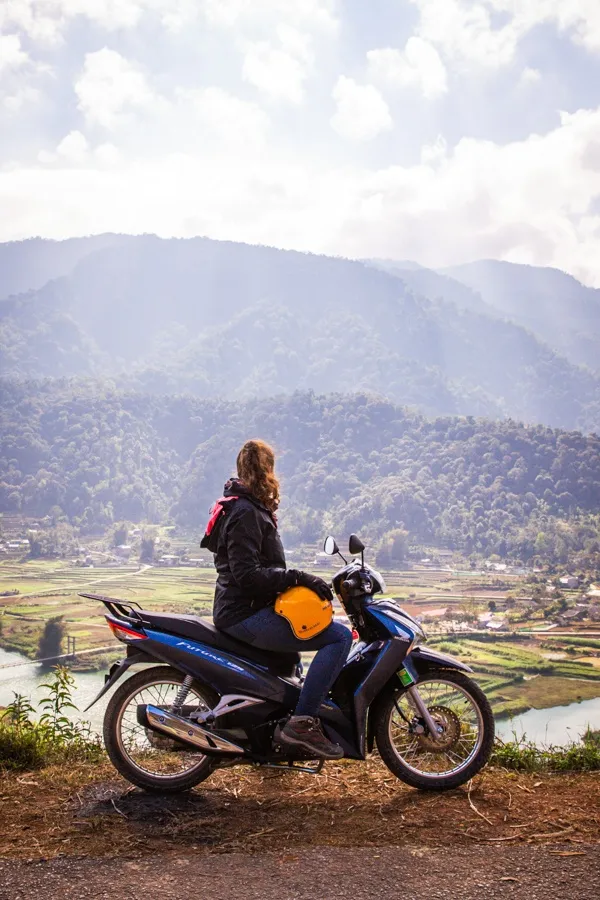 Spectacular mountain road views on the Ha Giang Loop, a highlight of Backpacking Through Vietnam
Spectacular mountain road views on the Ha Giang Loop, a highlight of Backpacking Through Vietnam
The Loop, typically completed over 3-4 days starting from Ha Giang city, takes you through limestone karsts, deep canyons (like the Ma Pi Leng Pass, one of Vietnam’s most famous viewpoints), and alongside rivers. The landscapes are raw, dramatic, and less visited than more southern areas. It’s a region where the distinct cultures of groups like the H’Mong, Dao, and Tay are still strongly preserved, and interactions with locals can be incredibly welcoming.
Riding the Loop yourself requires confidence and experience on a motorbike due to challenging mountain roads. A popular alternative is hiring an “easyrider,” a local guide who drives you on the back of their bike, allowing you to fully soak in the views without worrying about navigation or road conditions. The Ha Giang Loop is an adventurous and rewarding experience, offering some of the most authentic cultural encounters and stunning natural beauty Vietnam has to offer.
Optional Southern Gem: Phu Quoc Island
Located off the coast of southern Vietnam, close to Cambodia, Phu Quoc is Vietnam’s largest island and offers a different kind of experience – primarily focused on beaches and relaxation. While I haven’t personally visited, it’s a popular addition to many Vietnam itineraries for travelers seeking island vibes and sandy shores.
Phu Quoc is often praised for having some of the best beaches in Vietnam, offering a more laid-back atmosphere compared to coastal cities like Nha Trang. The island has seen significant development in recent years, with a range of accommodations from budget guesthouses to luxury resorts. Activities include swimming, sunbathing, snorkeling, diving, and exploring the island’s interior, which includes pepper farms, national park areas, and waterfalls.
If your Backpacking Through Vietnam route allows for extra time and you’re craving island life, Phu Quoc could be a worthwhile detour before or after exploring the mainland. Its proximity to Cambodia also makes it a convenient transit point for travelers heading between the two countries.
Practical Tips for Backpacking Through Vietnam
Getting around Vietnam is relatively straightforward, thanks to a well-established transportation network catering to backpackers. Understanding your options helps you plan your journey efficiently.
- Buses: The most common and often cheapest way to travel long distances. Sleeper buses are popular for overnight journeys, offering lie-flat beds that, while not luxurious, allow you to cover ground while you sleep. They are generally reliable and easier to book last minute, especially during peak travel times like Lunar New Year.
- Trains: A popular and scenic alternative, particularly the “Reunification Express” line running the length of the country. Trains offer varying classes of seats and berths and can be more comfortable and offer better views than buses during the day. Booking in advance, especially for popular routes or during holidays, is highly recommended.
- Motorbike: The ultimate adventure for many, buying a motorbike and riding it from south to north (or vice versa) offers unparalleled freedom and the chance to explore off-the-beaten-path areas. However, it comes with significant risks, including variable road conditions, traffic chaos, potential breakdowns, and licensing requirements. Many travelers successfully complete the journey, but be prepared for mechanical issues and prioritize safety.
- Taxis & Ride-sharing: Within cities, taxis are readily available. To avoid potential scams (like inflated fares or rigged meters), using ride-sharing apps like Grab (popular for both cars and motorbikes) is highly recommended. Grab provides upfront pricing and uses GPS tracking, offering peace of mind. Grab Bike is a very affordable and efficient way to navigate city traffic.
- Visa: Most tourists require a visa for Vietnam. The e-visa system is the most common and convenient option for many nationalities, including Americans, allowing you to apply and receive your visa online before arrival. Check the latest requirements and fees based on your nationality and intended length of stay.
Backpacking Through Vietnam is an immersive experience filled with incredible sights, sounds, tastes, and encounters. It’s an adventure that challenges and rewards, connecting you with a country rich in history, vibrant in culture, and stunning in natural beauty. With practical transport options and affordable costs, Vietnam remains an absolute must-visit for any backpacker in Southeast Asia.
Frequently Asked Questions About Backpacking Through Vietnam
How long should I plan for Backpacking Through Vietnam?
Most backpackers spend anywhere from 2 weeks to a month exploring Vietnam from north to south (or vice versa). Two weeks allows you to hit the major highlights relatively quickly, while three to four weeks provides a more relaxed pace, allowing for deeper exploration of specific regions, including side trips like Sapa, the Ha Giang Loop, or Phu Quoc.
What is the best time of year for Backpacking Through Vietnam?
Vietnam’s climate varies significantly from north to south. Generally, spring (February to April) and autumn (August to October) offer the most favorable conditions across the country, with pleasant temperatures and less rain. However, these are also peak seasons. Traveling during the shoulder seasons can mean fewer crowds but potentially more varied weather. Research the specific climate for the regions you plan to visit during your travel dates.
Is Vietnam safe for solo backpackers?
Vietnam is generally considered safe for solo travelers, including solo female travelers. Common sense precautions should be taken, just like anywhere else. Be mindful of your belongings, especially in crowded areas. Traffic can be chaotic, so exercise extreme caution when crossing streets. Scams related to taxis or tour bookings can occur, which is why using reputable companies or apps like Grab is advisable. Overall, violent crime is rare, and most interactions with locals are positive and welcoming.
What are the average costs for Backpacking Through Vietnam?
Vietnam is very budget-friendly. On a tight backpacker budget staying in hostels, eating street food, and using public transport, you can expect to spend around $25 – $40 USD per day. A more comfortable budget, including some private rooms, restaurant meals, and occasional tours, might range from $40 – $60+ USD per day. Accommodation and transport are generally inexpensive, while costs for tours (like Ha Long Bay or Sapa treks) will be significant expenditures but offer value for the experience.
What Vietnamese dishes must I try?
Vietnam is a food paradise! Absolute must-tries include:
- Pho: The iconic noodle soup, particularly Phở Bắc (Northern Pho) in Hanoi and Phở Nam (Southern Pho) in HCMC for comparison.
- Banh Mi: The delicious and versatile Vietnamese sandwich.
- Bun Cha: Grilled pork with vermicelli noodles, a Hanoi specialty made famous globally.
- Bun Bo Hue: Spicy beef noodle soup from Hue.
- Cao Lau & White Rose: Unique dishes found only in Hoi An.
- Goi Cuon: Fresh spring rolls.
- Vietnamese Coffee: Strong, often served with condensed milk (cà phê sữa đá). Don’t forget to try egg coffee in Hanoi!
